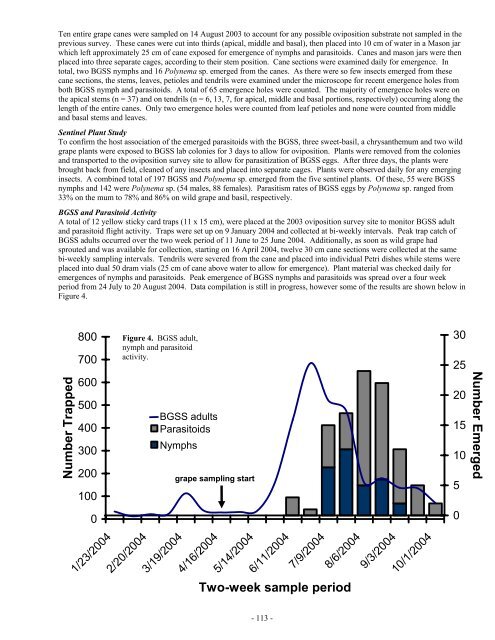Impact Of Host Plant Xylem Fluid On Xylella Fastidiosa Multiplication ...
Impact Of Host Plant Xylem Fluid On Xylella Fastidiosa Multiplication ...
Impact Of Host Plant Xylem Fluid On Xylella Fastidiosa Multiplication ...
You also want an ePaper? Increase the reach of your titles
YUMPU automatically turns print PDFs into web optimized ePapers that Google loves.
Ten entire grape canes were sampled on 14 August 2003 to account for any possible oviposition substrate not sampled in the<br />
previous survey. These canes were cut into thirds (apical, middle and basal), then placed into 10 cm of water in a Mason jar<br />
which left approximately 25 cm of cane exposed for emergence of nymphs and parasitoids. Canes and mason jars were then<br />
placed into three separate cages, according to their stem position. Cane sections were examined daily for emergence. In<br />
total, two BGSS nymphs and 16 Polynema sp. emerged from the canes. As there were so few insects emerged from these<br />
cane sections, the stems, leaves, petioles and tendrils were examined under the microscope for recent emergence holes from<br />
both BGSS nymph and parasitoids. A total of 65 emergence holes were counted. The majority of emergence holes were on<br />
the apical stems (n = 37) and on tendrils (n = 6, 13, 7, for apical, middle and basal portions, respectively) occurring along the<br />
length of the entire canes. <strong>On</strong>ly two emergence holes were counted from leaf petioles and none were counted from middle<br />
and basal stems and leaves.<br />
Sentinel <strong>Plant</strong> Study<br />
To confirm the host association of the emerged parasitoids with the BGSS, three sweet-basil, a chrysanthemum and two wild<br />
grape plants were exposed to BGSS lab colonies for 3 days to allow for oviposition. <strong>Plant</strong>s were removed from the colonies<br />
and transported to the oviposition survey site to allow for parasitization of BGSS eggs. After three days, the plants were<br />
brought back from field, cleaned of any insects and placed into separate cages. <strong>Plant</strong>s were observed daily for any emerging<br />
insects. A combined total of 197 BGSS and Polynema sp. emerged from the five sentinel plants. <strong>Of</strong> these, 55 were BGSS<br />
nymphs and 142 were Polynema sp. (54 males, 88 females). Parasitism rates of BGSS eggs by Polynema sp. ranged from<br />
33% on the mum to 78% and 86% on wild grape and basil, respectively.<br />
BGSS and Parasitoid Activity<br />
A total of 12 yellow sticky card traps (11 x 15 cm), were placed at the 2003 oviposition survey site to monitor BGSS adult<br />
and parasitoid flight activity. Traps were set up on 9 January 2004 and collected at bi-weekly intervals. Peak trap catch of<br />
BGSS adults occurred over the two week period of 11 June to 25 June 2004. Additionally, as soon as wild grape had<br />
sprouted and was available for collection, starting on 16 April 2004, twelve 30 cm cane sections were collected at the same<br />
bi-weekly sampling intervals. Tendrils were severed from the cane and placed into individual Petri dishes while stems were<br />
placed into dual 50 dram vials (25 cm of cane above water to allow for emergence). <strong>Plant</strong> material was checked daily for<br />
emergences of nymphs and parasitoids. Peak emergence of BGSS nymphs and parasitoids was spread over a four week<br />
period from 24 July to 20 August 2004. Data compilation is still in progress, however some of the results are shown below in<br />
Figure 4.<br />
Number Trapped<br />
800<br />
700<br />
600<br />
500<br />
400<br />
300<br />
200<br />
100<br />
Figure 4. BGSS adult,<br />
nymph and parasitoid<br />
activity.<br />
BGSS adults<br />
Parasitoids<br />
Nymphs<br />
grape sampling start<br />
30<br />
25<br />
20<br />
15<br />
10<br />
5<br />
Number Emerged<br />
0<br />
0<br />
1/23/2004 1/23/2004<br />
2/20/2004 2/20/2004<br />
3/19/2004 3/19/2004<br />
4/16/2004 4/16/2004<br />
5/14/2004 5/14/2004<br />
6/11/2004 6/11/2004<br />
7/9/2004 7/9/2004<br />
8/6/2004 8/6/2004<br />
Two-week Sample sample Periodperiod<br />
9/3/2004 9/3/2004<br />
10/1/2004 10/1/2004<br />
- 113 -











